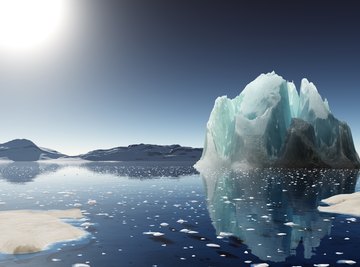
Carbon dioxide is essential to the survival of plants and animals. Too much, however, can cause all life on Earth to die. Not only do plants and animals need to ingest carbon dioxide, but they also rely on the gas to keep them warm, as it is an essential component to Earth's atmosphere.
TL;DR (Too Long; Didn't Read)
Carbon dioxide plays a key role in plant life and helps keep the earth warm. Increasing levels of carbon dioxide in the atmosphere, though, are linked to global warming.
Greenhouse Gas
Carbon dioxide is a naturally occurring greenhouse gas. Others include water vapor, methane and nitrous oxide. These gases help keep the Earth warm by absorbing the sun's energy and by redirecting energy back to the Earth's surface. An increase in the amount of carbon dioxide creates an overabundance of greenhouse gases that trap additional heat. This trapped heat leads to melting ice caps and rising ocean levels, which cause flooding.
Plants
Plants remove carbon dioxide from the atmosphere in a process called carbon sequestration. The carbon dioxide is stored in biomass then released by the plant. In most cases, the amount released is less than the amount consumed by the plant. Farms, grasslands and forests are considered sources or sinks of carbon dioxide, depending on the practices on these lands. For example, cows produce methane, but grass on the farm sequesters the gas.
Health
Carbon dioxide is essential for the survival of animals. Oxygen is carried to body tissue during breathing and carbon dioxide is released. The gas protects the pH level of blood. Too much carbon dioxide, however, can kill animals. If carbon dioxide is confined, it can decrease the amount of oxygen reaching the body. Any increase or decrease to the amount of carbon dioxide reaching the body can lead to kidney failure or coma.
Sources
Combustible fossil fuels such as coal, power plant gas, oil, vehicles and big industry are the largest source of carbon dioxide. The production is from various items such as iron, steel, cement, natural gas, solid waste combustion, lime, ammonia, limestone, cropland, soda ash, aluminum, petrochemical, titanium and phosphoric acid. Carbon dioxide accounts for nearly 85 percent of all emissions and is produced when natural gas, petroleum and coal are used. The major areas where these fuels are used include electricity generation, transportation, industry and in residential and commercial buildings.
References
About the Author
Sheri Lamb has been a reporter since 2006 in community newspapers throughout Canada. While she has covered virtually every beat associated with community newspapers, Lamb specializes in sports. In addition to her skills as a reporter, Lamb holds a certificate in computer programming. She also runs a small catering company.
